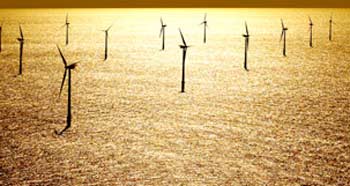
Pan-European Wind energy Supergrip
Proposed
Jun 1, 2006 - Jesse Jenkins - Watthead
 As
more wind energy projects go online in Europe, concerns
remain that additional wind generation will require
backup generation from other electricity production
to balance out times when the wind isn't blowing.
RenewableEnergyAccess reports that one of the world's
leading wind energy developers is thinking big and
thinks it has a solution to avoid concerns over backing-up
intermittent wind power while also offering a more
efficient, dynamic electric grid. As
more wind energy projects go online in Europe, concerns
remain that additional wind generation will require
backup generation from other electricity production
to balance out times when the wind isn't blowing.
RenewableEnergyAccess reports that one of the world's
leading wind energy developers is thinking big and
thinks it has a solution to avoid concerns over backing-up
intermittent wind power while also offering a more
efficient, dynamic electric grid.
Ireland-based Airtricity unveiled plans in May to
create a pan-European energy grid, or so-called 'Supergrid.'
Much of this Supergrid would be undersea linking the
growing number of European offshore wind farms and
would link a series of wind farms from as far ranging
locations as the Mediterranean, up to the Bay of Biscay
in the Atlantic and all the way up to the North Sea
and Baltic Sea.
"The scale of this undertaking means that when fully
operational Europe will have access to wind energy
at all times because the wind will always be blowing
somewhere on the grid," said Airtricity's Chief Executive,
Eddie O'Connor.
The company will formally introduce the ambitious
plan at a Parliamentary reception for MPs in Westminster
today. In conjunction, the wind energy developer will
also outline a proposal to build a Euro 22 billion,
10 gigawatt (GW) offshore wind energy project that
would cover a wind expanse in the North Sea between
the UK, Germany and the Netherlands. [Clearly, these
guys are thinking big!]
The company's Supergrid concept will play an important
complementary role for the project that would greatly
eclipse by size any current wind project, offshore
or on. As many as eight million European homes could
be powered by a project this size. Obviously, in the
absense of something like the Supergrid, a wind project
that large would require sizable amount of backup
generating capacity for times when the giant wind
farm is becalmed.
The Swedish transnational company ABB Ltd. will be
the project partner on the transmission side of the
Supergrid. ABB is the world's leader in the development
of high voltage direct current transmission lines.
Trevor Gregory, Managing Director of ABB said they
have established an advanced transmission technology
called 'HVDC Light' which, among a number of applications,
is used for demanding offshore applications. HVDC
Light not only feeds electricity to platforms but
it also connects and supports the integration of electrical
networks. [This sounds just like a normal HVDC system
to me, so I'm not sure what is so special about 'HVDC
Light', but oh well...]
Since the project will require the approval of the
EU, and involves multiple countries across almost
the entire span of the European continent, Airtricity
pitched the plan as an energy proposal for the wider
European Union, not to specific nations.
"The Supergrid offers a unique opportunity to Member
States to improve their security of energy supply,"
said the company, in a statement. "The power generated
will be a common European rather than a national asset.
Wind energy is a continental resource and thanks to
the Supergrid it will be the common property of all
the Member States.
Airtricity has plenty of wind energy experience,
operating, among others, the Arklow Bank wind farm,
the first real-world test of GE Energy's large 3.6
MW offshore wind turbines. The company is currently
expanding operations into Scotland, England, and parts
of the U.S. It currently has several thousands of
megawatts of capacity in the planning and construction
stages.
Well, clearly someone at least has the capacity to
think big! If Europe can succesfully execute a project
on this magnitude, I think it would go a long way
towards changing the way we think about energy projects.
There are a variety of renewable energy megaprojects
that could be constructued in the U.S. that would
rival Airtricity's plan in scale: I'm thinking here
in particular of a series of gigawatt-scale wind farms
in the Dakotas with electricity transmitted via HVDC
or hydrogen pipeline to demand centers like Denver,
Chicago, Minneapolis, etc. [if this idea intriuges
you, I'd check out these two reports here and here].
Other potential renewable megaprojects that would
require the vision and national (or transnation) committment
that Aitricity's plans would take include: * large-scale
solar farms in the Desert Southwest; * gigawatt-scale
offshore wind farms in the north-south axis of Lake
Michigan and the east-west axis of Lake Superior;
* similar scale wind projects (and maybe wave farms)
off the west coast of southern Oregon and northern
California; * massive wind farms in the Aleutian Island
chain (probably the windiest spot on earth with Class
7 winds over much of the archepelego) making hydrogen
for shipment to the continental U.S. via pipeline
or LH2 tankers
* ocean current turbines teathered in the middle
of the Gulf Stream [basically a massive undersea river
of seawater]
Those are the kind of megaprojects that immediately
come to mind. Each one could provide a major contribution
to the national energy mix and could even come to
dominate regional energy mixes. They would all however
require varying degrees of 'think big' vision that
hasn't been demonstrated in recent memory.
However, lest you think such megaprojects are impossible,
we need only look in our history books for the counterproof:
the massive federal hydropower projects constructed
beginning during the Great Depression/WPA era and
extending on through the 1950s and 60s. If we dare
to think big, big things can happen!

|